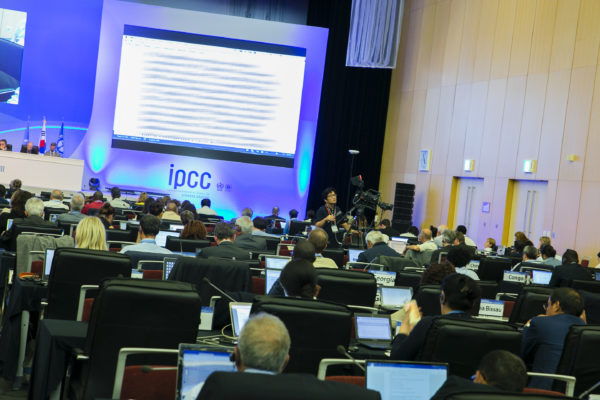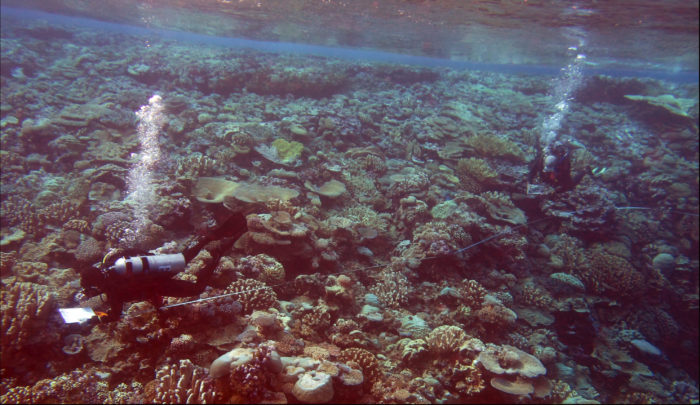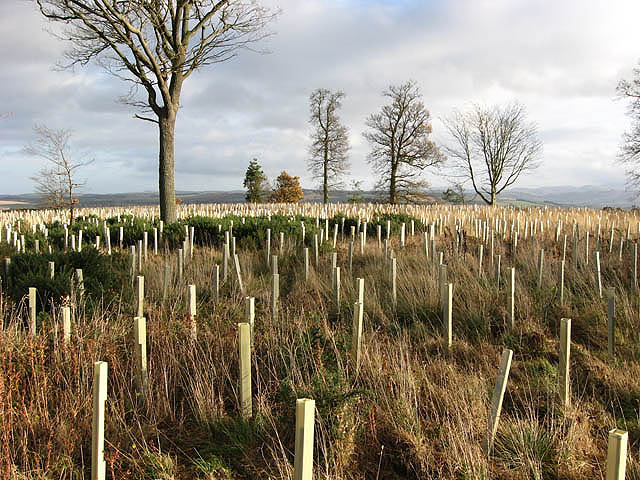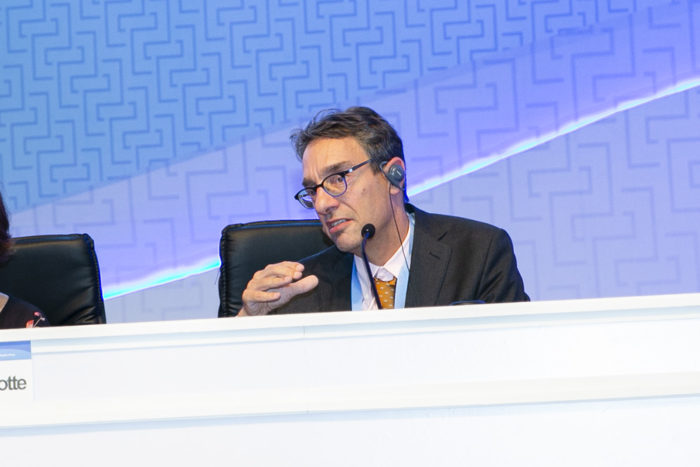“The most policy-relevant solution focussed report on climate change yet” – IPCC Special Report on 1.5°C

Limiting global warming to 1.5ºC would require rapid, far reaching and unprecedented changes in all aspects of society, the IPCC said in a new assessment.
With clear benefits to people and natural ecosystems, limiting global warming to 1.5ºC compared to 2ºC could go hand in hand with ensuring a more sustainable and equitable society, the Intergovernmental Panel on Climate Change (IPCC) said on Monday 15 October.
The Special Report on Global Warming of 1.5ºC was approved by the IPCC on Saturday in Incheon, Republic of Korea. It will be a key scientific input into the Katowice Climate Change Conference in Poland in December, when governments review the Paris Agreement to tackle climate change.
Professor Piers Forster, Director of the Priestley International Centre for Climate, and Professor James Ford, Priestley Chair in Climate Change Adaptation, are lead authors on the report and have spent the past week in Incheon working as part of the UK team to pass the final document.
“I’m exhausted but elated,” said Piers Forster, who is a lead author on the mitigation pathways chapter of the report. “As expected, we had all-night battles over the important numbers, but with the hard work of my amazing colleagues and strong support from small island nations and Europe, we won the day. The result is the most policy-relevant solution focussed report on climate change yet.”
James Ford, a lead author on Chapter 4, ‘”Strengthening and implementing the global response to the threat of climate change”, said: “I knew the session would be intense, and had heard that some people were concerned that the report might not be approved, but the final non-stop 30-hour session was quite something! The good news is that we have strong text that outlines the need for expanded ambition for decarbonisation, which has to start today if we are to reach the 1.5°C goal.”

James Ford (left) and Piers Forster at the IPCC meeting in Incheon
Consequences of global warming already being seen
Ninety-one authors and review editors from 40 countries prepared the IPCC report in response to an invitation from the United Nations Framework Convention on Climate Change (UNFCCC) when it adopted the Paris Agreement in 2015.
“With more than 6,000 scientific references cited and the dedicated contribution of thousands of expert and government reviewers worldwide, this important report testifies to the breadth and policy relevance of the IPCC,” said Hoesung Lee, Chair of the IPCC.
The report highlights a number of climate change impacts that could be avoided by limiting global warming to 1.5ºC compared to 2ºC, or more. For instance, by 2100, global sea level rise would be 10 cm lower with global warming of 1.5°C compared with 2°C. The likelihood of an Arctic Ocean free of sea ice in summer would be once per century with global warming of 1.5°C, compared with at least once per decade with 2°C. Coral reefs would decline by 70-90 percent with global warming of 1.5°C, whereas virtually all would be lost with 2ºC.
“One of the key messages that comes out very strongly from this report is that we are already seeing the consequences of 1°C of global warming through more extreme weather, rising sea levels and diminishing Arctic sea ice, among other changes,” said Panmao Zhai, Co-Chair of IPCC Working Group I.
The report also examines pathways available to limit warming to 1.5ºC, what it would take to achieve them and what the consequences could be.
“The good news is that some of the kinds of actions that would be needed to limit global warming to 1.5ºC are already underway around the world, but they would need to accelerate,” said Valerie Masson-Delmotte, Co-Chair of Working Group I.

Coral reefs could be wiped out by 2C of warming (photo: Dani Ceccarelli)
What is needed to limit warming to 1.5C?
The report finds that limiting global warming to 1.5°C would require “rapid and far-reaching” transitions in land, energy, industry, buildings, transport, and cities. Global net human-caused emissions of carbon dioxide (CO2) would need to fall by about 45 percent from 2010 levels by 2030, reaching ‘net zero’ around 2050. This means that any remaining emissions would need to be balanced by removing CO2 from the air.
“All the countries that have endorsed our report have signed off on some challenging numbers,” said Piers Forster. “They tell how global warming of more than 1.5°C will be a huge risk and to prevent it we must halve our emissions in 10 years. Current policies put us on course for a super-risky 3°C of warming.
“Transformations on energy that are already underway need to be massively scaled up, and transport, buildings and agricultural need to go zero carbon. Just like our negotiations this will be challenging, requiring global cooperation of an unprecedented level.”
Allowing the global temperature to temporarily exceed or ‘overshoot’ 1.5ºC would mean a greater reliance on techniques that remove CO2 from the air to return global temperature to below 1.5ºC by 2100. The effectiveness of such techniques are unproven at large scale and some may carry significant risks for sustainable development, the report notes.

Tree planting on a massive scale is one way to help reduce carbon in the atmosphere
“We must all act together to bring emissions down to zero”
The challenge of adapting to a warming climate will be easier in a 1.5°C world compared to 2°C, said James Ford, “Yet even at 1.5°C, vulnerable regions are going to see changes which will cause irreversible damages and require what we call ‘transformational adaptation’. This will not be easy and, particularly for low income countries, the ability to adapt will be stretched by a lack of resources.
“Support from the international community will be essential herein and the SPM headline statements provide strong backing for those at greatest risk to receive adaptation support through the UNFCCC. For high income nations, the adaptation statements also show that it is time to start investing in adaptation now.”
The Priestley Centre’s Professor Julia Steinberger, who was not involved in the 1.5°C report but is a lead author on the next IPCC global assessment report, said: “This report shows clearly that we must all act together to bring the emissions from fossil energy down to zero in the next twenty years. A rapid reduction on this scale is only possible if we communicate loudly, and join together to exert pressure on industries and politicians.”
Piers Forster confirmed the massive scale and rapid timing needed to achieve it: “The report shows that limiting warming to 1.5°C is barely feasible and every year we delay the window of feasibility halves. Nevertheless, if we were to succeed, we go onto show that benefits across society will be huge and the world will be all the richer for it. It’s a battle worth winning.”

Piers Forster, UK, Lead Author for SR15 Chapter 2 (Mitigation Pathways Compatible with 1.5°C in the Context of Sustainable Development) Photo by IISD/ENB | Sean Wu
The role of the IPCC
The IPCC is the leading world body for assessing the science related to climate change, its impacts and potential future risks, and possible response options. The report was prepared under the scientific leadership of all three IPCC working groups. Working Group I assesses the physical science basis of climate change; Working Group II addresses impacts, adaptation and vulnerability; and Working Group III deals with the mitigation of climate change.
The Paris Agreement adopted by 195 nations at the 21st Conference of the Parties to the UNFCCC in December 2015 included the aim of strengthening the global response to the threat of climate change by “holding the increase in the global average temperature to well below 2°C above preindustrial levels and pursuing efforts to limit the temperature increase to 1.5°C above pre-industrial levels.”
As part of the decision to adopt the Paris Agreement, the IPCC was invited to produce, in 2018, a Special Report on global warming of 1.5°C above pre-industrial levels and related global greenhouse gas emission pathways. The IPCC accepted the invitation, adding that the Special Report would look at these issues in the context of strengthening the global response to the threat of climate change, sustainable development, and efforts to eradicate poverty.
Global Warming of 1.5ºC is the first in a series of Special Reports to be produced in the IPCC’s Sixth Assessment Cycle. Next year the IPCC will release the Special Report on the Ocean and Cryosphere in a Changing Climate, and Climate Change and Land, which looks at how climate change affects land use.
The Summary for Policymakers (SPM) presents the key findings of the Special Report, based on the assessment of the available scientific, technical and socio-economic literature relevant to global warming of 1.5°C.
The Summary for Policymakers of the Special Report on Global Warming of 1.5ºC (SR15) is available at http://www.ipcc.ch/report/sr15/ or www.ipcc.ch.
Key statistics of the Special Report on Global Warming of 1.5ºC
91 authors from 44 citizenships and 40 countries of residence
14 Coordinating Lead Authors (CLAs)
60 Lead authors (LAs)
17 Review Editors (REs)
133 Contributing authors (CAs)
Over 6,000 cited references
A total of 42,001 expert and government review comments
(First Order Draft 12,895; Second Order Draft 25,476; Final Government Draft: 3,630
Main image: The IPCC meeting at Incheon (Photo by IISD/ENB | Sean Wu)
